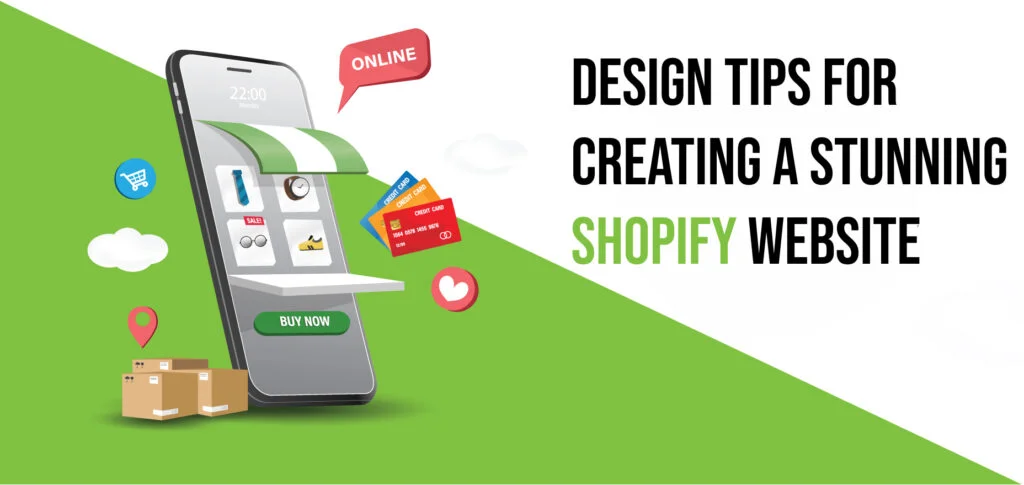Design Tips for Creating a Stunning Shopify Website
Creating a stunning Shopify website isn’t just about making things look pretty; it’s about crafting a user experience that’s intuitive, engaging, and effective. Whether you’re launching a new online store or revamping an existing one, getting the design right is crucial.
In this guide, we’ll walk you through practical tips to help you design a Shopify website that stands out and converts visitors into customers.
The Secret of a Memorable Shopify Store

Think of your Shopify store as a digital version of a physical shop where every little detail matters. Just like when you walk into a brick-and-mortar store, first impressions online are vital.
By incorporating elements that showcase your brand’s unique personality and creating a user-friendly design, you can turn casual visitors into loyal customers.
To make your online store memorable, focus on creating a welcoming atmosphere with appealing visuals, interactive features, and easy-to-navigate design.
Here are some shopify design tips for creating a stunning website.

Start with a Clear Vision
Before diving into design, take some time to define your website’s goals. Are you aiming to boost e-commerce sales, increase brand awareness, or enhance customer engagement? Understanding what you want to achieve will guide your design decisions. Sketch a rough idea of your site’s look and the features you need. This vision will keep your design process focused and efficient.
Choose the Right Shopify Theme
Shopify offers a variety of themes to get you started. While it’s tempting to choose a theme based solely on aesthetics, consider how well it matches your brand and business goals. Opt for responsive themes that look great on all devices, from desktops to smartphones. A good theme should also be customizable, allowing you to adjust colours, fonts, and layouts to fit your brand.
Keep Your Design Clean and Simple
Simplicity is key to great website design. A clean layout with ample white space helps visitors focus on what’s most important: your products and services. Avoid cluttering your pages with multiple elements. Use clear headings, concise text, and well-placed images to guide visitors through your site.
Optimize for Mobile Devices
With more people shopping on their phones, making sure your Shopify website is mobile-friendly is crucial. Check your site on different devices to make sure it looks good and works properly on all screen sizes. Even though Shopify themes usually adjust well to different devices, make sure your text is easy to read, buttons are easy to click, and images look right on mobile phones.
Use High-Quality Images
Images are usually the first thing people see, so they should be clear and match your products. Use professional photos or well-made graphics to show off your items. Steer clear of generic stock images, as they can make your site seem less genuine. High-quality visuals help build trust and make your site more appealing.
Create a User-Friendly Navigation
An organized navigation menu helps visitors find what they’re looking for quickly. Keep your menu simple with clear labels and avoid overwhelming users with too many options. Group related products and categories logically, and ensure your search function is easy to find and use. Good navigation enhances the user experience and can lead to higher conversion rates.
Incorporate Your Brand’s Personality
Your website design should represent your brand’s personality and values. Choose colours, fonts, and design elements that match your brand’s identity. Whether your brand is modern and sleek or fun and quirky, make sure your website reflects that. Consistent branding helps create a unified experience and boosts brand recognition.
Focus on Fast Load Times
A slow-loading website can frustrate users and drive them away. To ensure your site runs smoothly, optimize its performance by compressing images, reducing code, and selecting reliable hosting. Shopify provides tools to monitor and enhance your site’s speed, so regularly check its performance and make any necessary adjustments. Fast loading times not only enhance the user experience but also boost your SEO rankings.
Use Clear Calls to Action (CTAs)
Effective CTAs guide users toward taking specific actions, such as making a purchase, signing up for a newsletter, or contacting you for more information. Make your CTAs stand out and use persuasive, action-oriented language. Place them strategically throughout your site to encourage engagement. Well-crafted CTAs drive conversions and help you achieve your website’s goals.
Incorporate Customer Reviews and Testimonials
Social proof can significantly enhance your site’s credibility and encourage purchases. Feature customer reviews and testimonials on your product pages or homepage to build trust with potential buyers. Positive feedback from previous customers reassures new visitors about the quality of your products or services. Showcasing reviews and testimonials makes your site more trustworthy and persuasive.
Make Your Checkout Process Smooth
A smooth checkout process is key to turning visitors into buyers. Keep it simple by cutting down the number of steps and fields required to make a purchase. Offer different payment options and ensure your checkout page is secure. A quick and easy checkout helps reduce abandoned carts and increases the chances of sales.
Integrate Social Media
Social media integration can improve your website’s design and functionality. Add social media buttons so visitors can easily follow you, share your content, or connect with your brand on other platforms. You might also embed social media feeds or include social proof features to highlight your brand’s online presence and encourage more interaction.
Regularly Update Your Content
A stunning website isn’t just about its initial design; it’s also about keeping your content fresh and relevant. Regularly update your site with new products, blog posts, promotions, and other updates. This helps with SEO and keeps visitors interested and returning. Fresh content shows that your site is active and relevant, which boosts user engagement and improves search engine rankings.
Implement SEO Best Practices
Search engine optimization (SEO) is crucial for attracting traffic to your Shopify website. Incorporate relevant keywords into your page titles, meta descriptions, and product descriptions. Optimize images with descriptive alt text and make sure your site’s structure is search-engine friendly. A well-optimized site will rank better in search results and attract more organic traffic, driving more potential customers to your store.
Test and Refine
Designing a stunning Shopify website is an ongoing process. Regularly test different design elements, layouts, and features to see what works best for your audience. Use analytics tools to track user behaviour and make data-driven decisions to refine and improve your site over time. Continuous testing and refinement ensure your site remains effective and engaging.
Also Read: Shopify vs. WordPress WooCommerce User Experience
Conclusion
Creating a stunning Shopify website isn’t just about making it look good; it’s also about ensuring it’s easy to use, performs well, and fits your brand. By following these shopify design tips and focusing on usability and performance, you can build an online store that not only looks impressive but also delivers results.
Whether you’re building a new site or improving an existing one, remember that the best websites blend great design with functionality. Keep your audience’s needs in mind, stay updated with design trends, and always aim for a smooth, enjoyable user experience.





